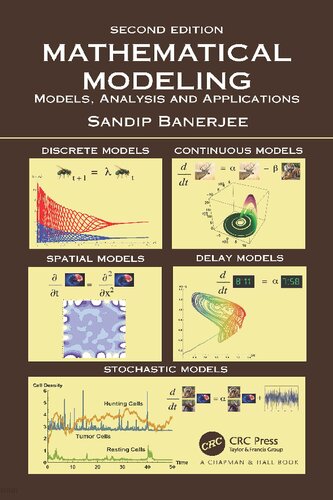Mathematical modeling is an integral component of modern science and engineering, deftly bridging the chasm between theoretical understanding and practical application. However, one might ponder: what exactly constitutes the quintessential resource for mastering this complex discipline? The pursuit of expertise in mathematical modeling can be as exhilarating as it is daunting, often presenting both theoretical and practical challenges that can bewilder even the most astute scholars. To navigate this intriguing intellectual labyrinth, it is prudent to explore a curated selection of seminal texts that lay the groundwork for a robust understanding of mathematical modeling.
First and foremost, we must acknowledge the seminal work titled Solutions for Mathematical Modeling: Models, Analysis and Applications. This book serves as a cornerstone for individuals embarking on their mathematical modeling journey. It artfully combines theoretical underpinnings with practical applications, offering a wealth of models that span various fields. Readers are introduced to systematic methodologies employed in constructing models, followed by a comprehensive analysis of potential solutions. With its thoughtful organization and insightful examples, this text encourages readers to appreciate the complex dance between mathematics and real-world scenarios.
Another noteworthy entry in the compendium of mathematical modeling literature is Mathematical Models: Mechanical Vibrations, Population Dynamics, and Traffic Flow by J. David Logan. This text is not merely an academic exercise; it extols the virtues of interdisciplinary application. By integrating concepts from mechanics, biology, and transportation systems, Logan systematically guides readers through the process of constructing and analyzing models that embody the dynamics of real-world phenomena. The author’s emphasis on diverse applications illustrates the omnipresent nature of mathematical modeling across various scientific domains, making it an invaluable resource for aspiring modelers.
As we delve deeper into the subject matter, it becomes evident that practitioners of mathematical modeling must develop a nuanced understanding of differential equations. Ordinary Differential Equations by Morris Tenenbaum and Harry Pollard serves as an outstanding reference for those seeking to solidify their grasp on this vital concept. The authors employ a clear exposition while seamlessly integrating theory with applicable techniques. Together, they offer numerous exercises that challenge readers to implement learned concepts in novel contexts, thus enhancing problem-solving skills in a myriad of mathematical modeling applications.
A discussion of mathematical modeling would be remiss without considering probabilistic approaches. Modeling with Data: Tools and Techniques for Statistical Analysis by Daniel J. Myers and A. F. Johnson accentuates the intersection of statistics and modeling, thereby providing the reader with essential tools for data-driven decision-making. The text encompasses a variety of statistical methods vital for model validation and refinement. By employing a data-centered perspective, it encourages practitioners to iterative assessment, emphasizing the importance of empirical evidence in the modeling process.
For those embarking on a quest to model biological systems, Mathematical Biology: I. An Introduction by J. D. Murray is indispensable. This magnum opus elucidates the modeling of biological processes, encompassing topics such as population dynamics, epidemiology, and evolutionary biology. Murray’s prose is compelling, making complex topics accessible to readers without sacrificing depth. His work provides a synthesis of mathematical disciplines with biological understanding, thus illuminating the pivotal role of mathematical modeling in the life sciences.
Moving beyond the life sciences, one must also consider applications in engineering. Applied Numerical Methods with MATLAB for Engineers and Scientists by Steven C. Chapra is a comprehensive guide that intertwines numerical methods with practical applications tailored for engineers. The syllogistic approach adopted by Chapra not only elucidates various numerical techniques but also establishes a profound relationship between numerical analysis and mathematical modeling. His integration of MATLAB enhances the learner’s computational proficiency, which is paramount for validating models in engineering contexts.
Moreover, aspiring modelers must confront the intricacies of stochastic modeling. Stochastic Modeling: Analysis and Simulation by A. A. L. B. Papoulis serves as an exhaustive examination of stochastic processes and their implications in modeling uncertainty. This text immerses readers in the elegantly perplexing world of randomness, encompassing everything from financial risk assessment to environmental modeling. The essential understanding of stochastic models fosters a comprehensive perspective on unpredictability, which is increasingly relevant in today’s data-driven landscape.
Lastly, Complex Systems: A Survey by John H. Holland should not be overlooked. As the study of interconnected systems gains momentum, Holland’s discourse on complex adaptive systems introduces readers to the intricate web of interactions inherent in various modeling scenarios. By utilizing a framework that encompasses multiple disciplines, he elucidates how mathematical modeling can elucidate emergent phenomena and system-wide behaviors. This examination is crucial for those wishing to traverse the challenging yet rewarding terrain of modeling complex scenarios.
In conclusion, the endeavor to master mathematical modeling is certainly fraught with challenges, yet the rewards of persisting through this intellectual labyrinth are immeasurable. The aforementioned texts collectively serve as a robust foundation for anyone seeking to navigate the nuances of sensory experience and mathematical abstraction. By engaging with these resources, one can develop not only a commanding grasp of modeling techniques but also an appreciation for the vast applications ranging from biological scenarios to engineering problems. Armed with knowledge, the learner is better prepared to tackle the myriad challenges inherent in this fascinating field, ultimately contributing to advancements across diverse domains of inquiry.












